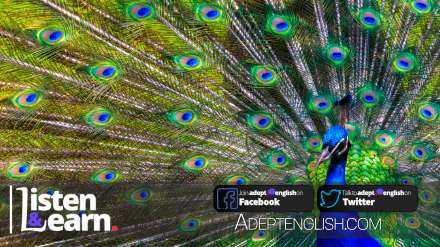Practice English Conversation On The Many Types Of Blue
Maybe it is the plunge in temperature that made me think about today’s colour, or maybe the wonderful flowers that have coloured my garden. The result is an English conversation practice podcast that takes a thorough analysis into the many types of a single colour. I will leave you to listen to the podcast to find out which colour I talk about.
In the UK we are having a weird Spring. It started with some of the hottest days I can remember for Spring, followed by some really bitterly cold days. However, nothing will put us British off meeting up and enjoying the simple pleasure of chatting with friends in the garden. As the pandemic restrictions are being lifted in the UK with the success of the vaccine rollout, we are all desperately keen on meeting up and enjoying socialising.
I get the impression that as people get a whiff of freedom; the British are getting ready to party. The roads are full of cars again. Shops are full and busy. I imagine the economy is about to see a major boost, as in a week most of the shops still required to be closed will be open and back to normal. With masks the only real requirement for entry, and at some point that will become unnecessary as well.
Maybe it’s because of Spring, but I get a genuine feeling from the people I speak with, that people are planning for post lock downs and are desperate to do a lot of catching up on the things we’ve all missed out on.
Most Unusual Words:
Aquarium
Irridescence
Shade
Most common 2 word phrases:
| Phrase | Count |
|---|---|
| In English | 4 |
| Words For | 4 |
| English Language | 4 |
| Listen To | 3 |
| A Reminder | 3 |
Listen To The Audio Lesson Now
The mp3 audio and pdf transcript for this lesson is now part of the Adept English back catalogue . You can still download and listen to this lesson as part of one of our podcast bundles.Transcript: English Conversation Practice On Words That Help Describe The Colour Blue
Hi there and welcome to this latest podcast from Adept English. Well, it’s been the long weekend for Easter here in the UK, so most people had four days’ holiday. We’ve been having quite nice weather too and in fact it was the hottest March day in the UK at 25C last Tuesday. However, there’s an arctic blast of cold air here now, so although it is still sunny, brrrr, it’s also cold.
This matters because we are now allowed in the UK to have six people together to meet up - outside. So it was brrrr for those social events over Easter! Never mind. So here we are, helping English language learners master the English language. Listen to this podcast a number of times until you can understand all the words. And with repeat listening you will be more likely to remember any new words too.
Words for colour
So today’s subject? Well, how about we cover some different words for colours in English? You will probably have learned the main words for colour in your language course, or when you were at school. Or you may have learned them in some other way.
I’ll run through the basic colours in English as a reminder and then let’s get into some other descriptive words for colour, so that you can increase your vocabulary. We like to get ‘descriptive’ in English conversation, so these are words which might catch you out, if you’ve not heard them before. So let’s look today at ‘shades of blue’.
So first of all – the main colours in English are:- black, white, blue, red, yellow, green, orange, purple, pink, brown and grey.
And notice that last colour, grey, which is a mix of black and white. If you’re using American English you would spell that one with an A – GRAY and if you’re using UK English, you’d spell it GREY, as it’s spelt in Australia, New Zealand and even in Canada. But GRAY in the US.
Video
A reminder about Course One Activate Your Listening
Just a reminder before we go any further. If you’d like some more practice, some more English language to listen to, then don’t forget to visit our courses page on our website at adeptenglish.com. Our Course One Activate Your Listening gives you lots of English language listening and is more structured than the podcasts.
Boost Your Learning With Adept English
It builds your vocabulary on several different topics and it’s structured so that you can learn gradually through ‘phased repetition’. The course also contains quite a lot of English conversation practice – with two speakers, so you get to listen to that too. It’s similar to the podcasts for learning, but you also get more than the podcasts, including practising your understanding of English for conversation.
Shades of blue
OK, back to today’s subject. So what about other colour names? This is part of our project to learn everyday English for speaking and listening.
Azure and turquoise
If we take the colour blue, for example, BLUE – that’s the colour of the sky in the middle of day, if the sun is shining. Well, there are words for blue which reflect the colour of the sea. And I’m talking the sort of sea blue that you see in the Mediterranean, or the Caribbean or different holiday resorts around the world – that’s rather than the sort of blue you might see in the sea around the UK!
So, we might call this bluey-green sea colour ‘azure’, AZURE, ‘azure’. Another common colour word for blue-green, comes from the gemstone, or the mineral ‘turquoise’. That’s spelt TURQUOISE. So you might say ‘I’m going to wear my turquoise dress today’. Or you might have a genuine turquoise stone set in piece of jewellery, and you might say ‘I’m going to wear my turquoise necklace today’. I love turquoise – it gives pleasure to my eyes.
Navy blue
So when we talk about different types of a colour like blue, we might use the word ‘shade’ – different ‘shades’ of blue – that’s SHADE. So other common shades of blue that you might come across – navy blue, that’s NAVY blue. This is a very dark blue – the sort of blue that’s used for uniforms. And of course, it’s from the word ‘navy’, the naval force – the part of the armed forces that sails on ships. So navy blue is the sort of blue you might find in a school uniform too – or a police uniform. It tends to be used of clothes, navy, but it’s a shade of blue that English speakers would all know.
Royal blue
Another shade of blue – royal blue. In the UK, this means a mid-blue, a strong blue colour. It’s meant to come from a time where there was a competition to make a dress for Queen Charlotte, the wife of George III. And this was the colour of the dress which won, which in time became known as ‘royal blue’. So anything to do with the Queen and her family, is the ‘royal’ family, ROYAL. And like navy blue, this colour, royal blue tends to get used used for clothing.
Cyan blue
Another blue? Cyan blue – this is sometimes the name used for the colour blue in printer cartridges. That’s CYAN. A printer is a technology device – it’s what you use for printing documents, printing on paper. And the cartridge, CARTRIDGE, is the part you replace which contains the ink, INK for printing. So if you have a colour printer for printing documents, you might find yourself having to buy colour print cartridges – in cyan, magenta, yellow and black.
Magenta, MAGENTA is a purply-red colour – and cyan is the blue we’re talking about here. In combination, these four colours, cyan, magenta, yellow and black are used to create colours when you print.
Blue artists’ paint shades
If you buy artist’s paints, if you want to paint a picture, there are all kinds of shades of blue when you buy paint. I suspect some of these names may be the same in other languages. There is cobalt blue, ultramarine blue, caerulean blue. That means blue which is the colour of the sky – from caeruleus in Latin, means the same and probably comes from the Latin caelum, meaning ‘sky’.
Pale blue and light blue
For any colour, if you have the word ‘pale’ in front, PALE, that means it’s a light shade of that colour. So pale blue means lighter blue, pale green, lighter green, pale yellow….so it’s just a lighter shade of the colour, as though white is mixed in. You could also say ‘light blue’ or ‘light green’. And I guess you would call ‘pale red’, ‘pink’ and ‘pale purple’ would be ‘mauve’, or ‘mauve’ some people say, MAUVE, so that’s another colour name, which is a pale purple.
Download The Podcast Audio & Transcript
Powder blue
We might also talk about ‘powder blue’. Powder, POWDER is a form of a substance – like flour for baking is a powder or we might use ‘washing powder’ – the white powder that you use in your washing machine, when you wash your clothes. Or talcum powder, TALCUM is another powder – you might put that on your body. Anyway ‘powder blue’ is a pale blue, with a slightly purple tinge to it. It’s a nice colour for a dress or a hat or a tie, if you’ve got a posh event to go to! That’s powder blue.
Electric blue
And finally - electric blue! If you think about going to an aquarium, where you might view fish in tanks swimming about. It’s a sort of tourist attraction and they’ve probably been closed for months at the moment, because of the pandemic. But sometimes you see tiny little fish in aquariums – a type called ‘Neon Tetra’ for example. And they’re stripey with shiny, blue and orange stripes.
Well, the shiny, reflective blue colour there, we might call that ‘electric blue’. It’s a colour with a quality which we call ‘irridescence’, IRRIDESCENCE. And that’s when a colour is particular bright and shiny and reflective of the light. If you think also of a peacock’s feathers – PEACOCK. A peacock is a male bird and the peahen is the female bird. And it’s the kind that likes to opens up its tail to show off.
📷
A photograph of a shop with a profusion of colours. As we take a deep dive on the many types of blue in the English language.
If you put peacock, PEACOCK into your search engine, you’ll see photographs and you’ll know what I mean. Well, the blue of that bird’s feathers – we’d probably call that ‘electric blue’. It’s such a bright blue that it’s as though there’s electricity running through it!
Anyway, that’s a tour of the main shades of blue in English for conversations involving colours, each with a bit of association to help you remember the vocabulary and make sense of it. If you like this podcast, then please give us a review or some feedback – let us know what you thought of it. And if you like this one, I’ll do some other podcasts, which describe vocabulary for colours.
Goodbye
Anyway, enough for now. Have a lovely day. Speak to you again soon. Goodbye.





